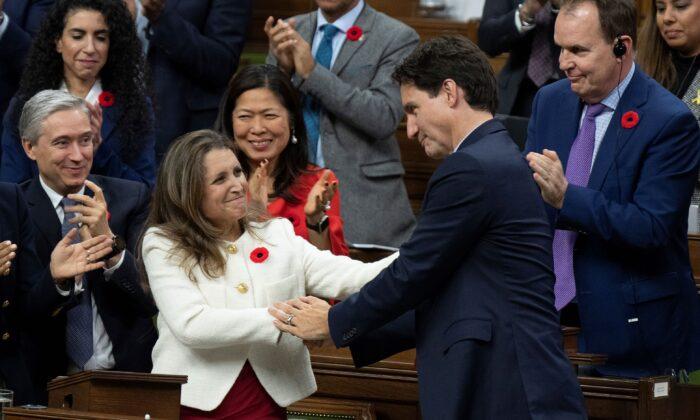OTTAWA—The government’s Fall Economic Statement (FES) on Nov. 3 announced $30 billion in more spending, yet despite warning of an impending recession, its main projection shows an improving fiscal picture and a potential return to black ink.
The FES is the government’s fall mini-budget. Under the government’s base-case official projection, which assumes the economy narrowly avoids a recession, the deficit for the current fiscal year ending in March 2023 is $36.4 billion. The feds project deficits to continue shrinking until attaining a fiscal surplus of $4.5 billion in 2027-28.
But given growing expectations of a recession as central banks raise interest rates aggressively, the feds provided a downside scenario which forecasts an economic contraction of 0.9 percent in 2023. Under this scenario, the deficit would be $49.1 billion in 2022-23 and it remains in the red, decreasing to $8.3 billion in 2027-28.
For the current fiscal year 2022-23, the Parliamentary Budget Officer on Oct. 13 projected the deficit to hit $25.8 billion under status quo policy.
The government’s “fiscal anchor” is the unwinding of COVID-19 related deficits and reducing the federal debt-to-GDP (gross domestic product) ratio over the medium term. That debt sustainability ratio is projected to decline from 46.5 percent in 2021-22 to 41.5 percent in 2026-27.
Given the rapid rise in interest rates, the government’s interest expense is projected to rise over the projection window, starting at $34.7 billion in 2022-23.
The federal debt is projected to grow from roughly $1.13 trillion in March 2022 to almost $1.25 trillion in 2027-28.
GST Credit
The doubling of the GST credit for six months, announced on Sept. 13, will cost the government $2.475 billion and is the biggest single measure in the “Making Life More Affordable” part of the FES.
The government says that starting Nov. 4, about 11 million low- and modest-income current GST credit recipients will receive an additional payment.
Also, interest on the federal portion of all Canada Student Loans and Canada Apprentice Loans will be permanently interest-free.
Nevertheless, government’s projections predict the most encouraging net debt forecasts among the G7.
“As the Bank of Canada fights inflation, we will not make its job harder,” Finance Minister Chrystia Freeland told the House of Commons. She added that the feds are forecasting that the deficit will come down to 1.3 percent of Canada’s $2.8 trillion economy.
A senior government official said that the spending measures in the FES will not contribute to additional inflation. As a rule of thumb, he said that program spending of 1 percent of GDP contributes 0.2 percent to inflation and that if the economy is growing at a rate of 3 to 4 percent, it could spend $15 billion without accelerating inflationary pressures.
“We’re doing much less than that,” he said, adding that only when spending is increasing as share of GDP does it have an inflationary impact.
Share Buyback Tax
One measure that was rumoured prior to the release of the FES was the government’s intention to tax share buybacks. The feds plan to impose a 2 percent tax that would apply to the net value of all types of share buybacks by public corporations in Canada.
This is similar to a measure introduced in the United States. Details of the new tax will be coming in the next budget and enter into effect on Jan. 1, 2024. The measure is expected to raise federal revenues by $2.1 billion over five years starting in 2023-24.
Share buybacks are one method of returning corporate profits to shareholders. Oil and gas companies have been rewarding their investors in this manner as energy prices soared, and the government said investment remains muted in the sector following Russia’s invasion of Ukraine, hampering Canada’s productive capacity.
“The U.S. put in place the same tax in the Inflation Reduction Act,” Freeland told reporters.
“I think it is a smart tax … more importantly [than the fiscal impact] it creates the right set of incentives [for companies].”
The senior government official termed the U.S. Inflation Reduction Act a “game-changer” for retooling the industrial structure of the United States, attracting investment capital, and that it mandates Canada to respond accordingly to remain competitive.





